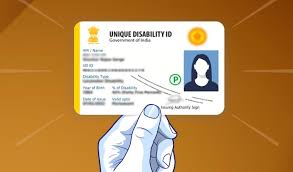Unique Disability ID (UDID) Card:

Less than 40% of India’s projected population of Persons with Disabilities (PwDs) have been issued a Unique Disability ID (UDID) Card, which enables access to government benefits, data show.
- A UDID card is a single document of identification for Persons with Disabilities (PwDs).
- It is the universal ID that is accepted all across the country.
- As per the Rights of Persons with Disabilities (RPwD) Act, 2016, UDID cards can be issued by home district hospitals as well as the hospital where the PwD is taking medical treatment.
- The UDID card has a total of 18 digits/characters.
- The first 2 characters represent State Code, the next 2 digits for the district code, the next 1 digit for the CMO code, the next 2 digits for disability type, the next 4 digits for year of birth of PwD, the following 6 digits for running number, and the last digit for check sum which is involved for security reasons.
- Three types of colour-based UDID Cards are issued based on the severity of the disability:
- White Card: When the disability percentage of a PwD is below 40%.
- Yellow Card: When the disability percentage of a PwD is above 40% but on or below 80%
- Blue Card: When the disability percentage of a PwD is above 80%.
- Unique ID for Persons with Disabilities Project (UDID Project) is initiated by the Department of Empowerment of Persons with Disabilities, Ministry of Social Justice & Empowerment.
- It is being implemented to create a national database of PwDs and issue a Unique Disability Identity Card (UDID) to each individual.
- It also aids in tracking the physical and financial progress of beneficiaries across various administrative levels — village, block, district, state, and national.
- It aims to build a comprehensive end-to-end system for issuing Universal IDs and Disability Certificates.




